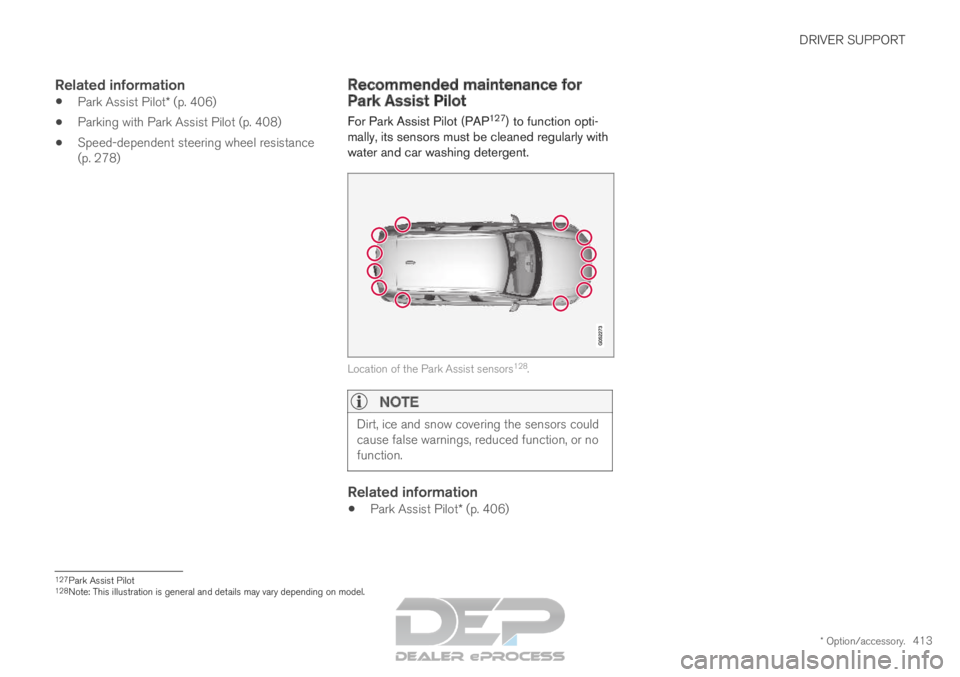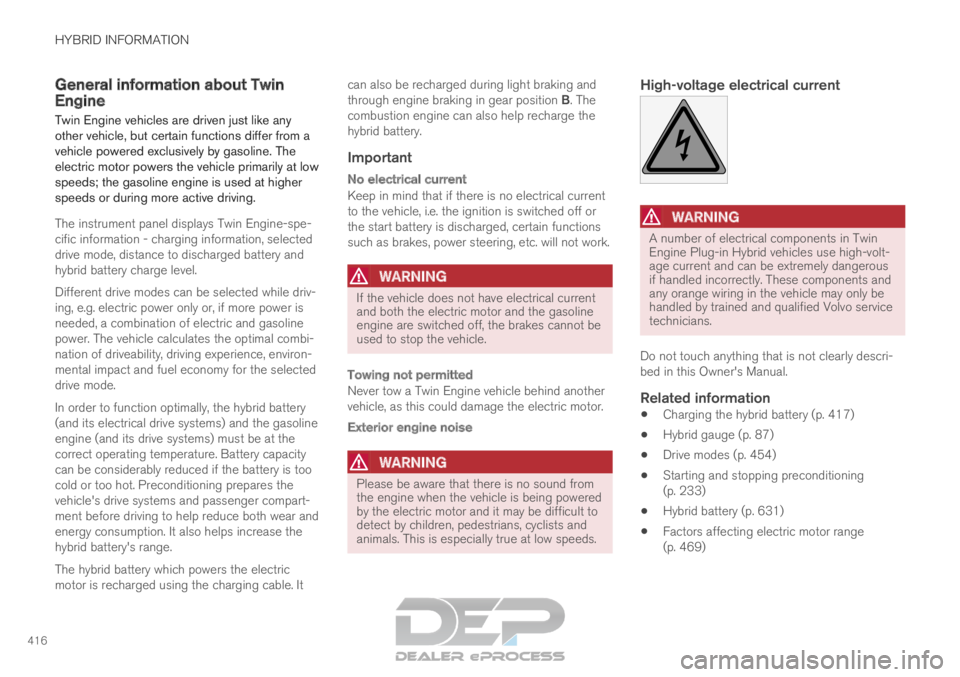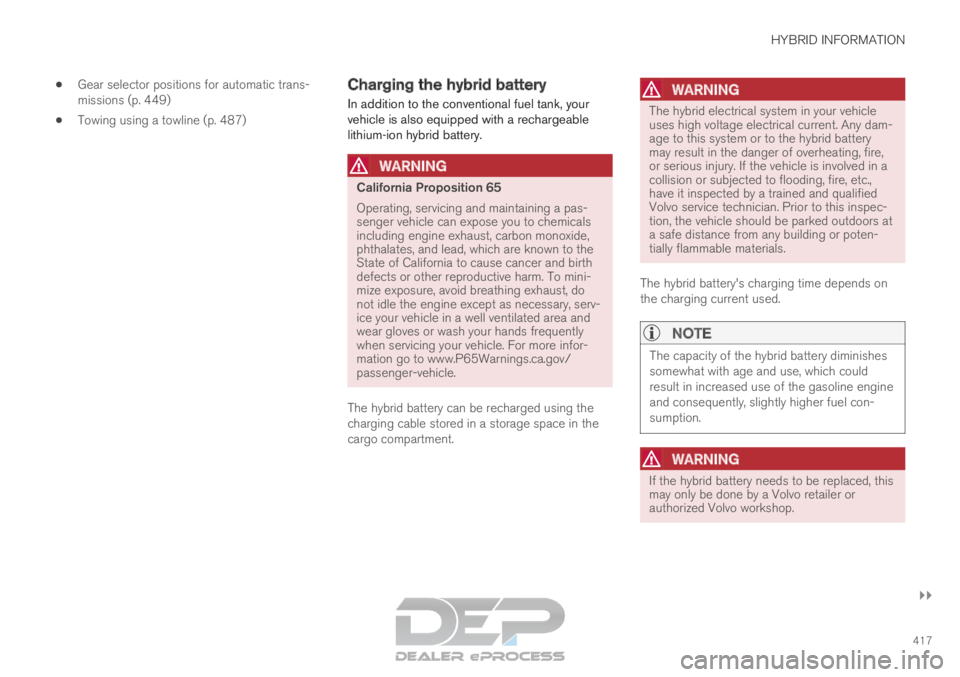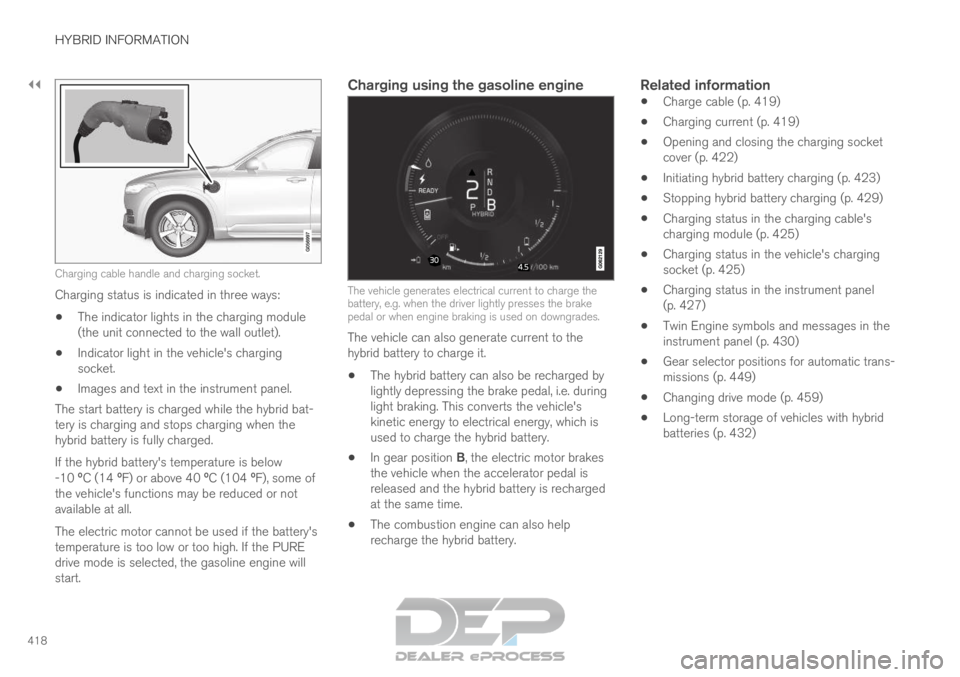VOLVO XC90 TWIN ENGINE 2019 Owners Manual
Manufacturer: VOLVO, Model Year: 2019, Model line: XC90 TWIN ENGINE, Model: VOLVO XC90 TWIN ENGINE 2019Pages: 697, PDF Size: 10.33 MB
Page 411 of 697

DRIVER SUPPORT
}}
409
1.
The vehicle's speed may not exceed
30 km/h (20 mph) when parallel parking or
20 km/h (12 mph) when perpendicular park-
ing.
2. Tap Park In in Function view or in Camera
view.
>
PAP will search for a potential parking
space and measure it to determine if it is
big enough.
3. Be prepared to stop the vehicle when a graphic and message in the center display
indicate that a suitable parking space has
been found.
> A pop-up window will appear.
4. Select Parallel parking or Perpendicular
parking and engage reverse gear.
NOTE PAP searches for space for parking, shows
instructions and guides the vehicle on its pas-
senger side. But, if so desired the vehicle can
be parked on the driver's side of the street:
Activate the turn signals on the driver's
side – the system will then search for
space to park on that side of the vehicle
instead.
Backing into a parking space Parallel.
Perpendicular.
To back into a parking space:
1.
Make sure the path behind your vehicle is
clear and engage reverse gear. 2. Back up slowly and carefully without touch-
ing the steering wheel and do not exceed a
speed of 7 km/h (4 mph).
3. Be prepared to stop the vehicle when instructed to do so by a graphic and mes-
sage in the center display.
NOTE
Keep your hands away from the steering
wheel when the PAP function is acti-
vated.
Make sure that the steering wheel is not
hindered in any way and can rotate freely.
To achieve the best results – wait until
the steering wheel is finished turning
before beginning to drive forward/in
reverse.
Page 412 of 697

||DRIVER SUPPORT
* Option/accessory.
410
Positioning the vehicle in the parking space Parallel.
Perpendicular.
To do so:
1. Move the gear selector to D, wait until the
steering wheel turns and then drive slowly
forward. 2.
Be prepared to stop the vehicle when
instructed to do so by a graphic and mes-
sage in the center display.
3. Engage reverse gear and back up slowly.
4. Be prepared to stop the vehicle when instructed to do so by a graphic and mes-
sage in the center display.
The function will switch off automatically and a
graphic and message will appear to indicate that
parking has been completed. Adjustments can
always be made be the driver afterward. Only the
driver can determine when the vehicle is correctly
parked.
CAUTION The warning distance is shorter when the
sensors are used by PAP compared to when
they are used by the Parking Assist system.
Related information
Park Assist Pilot* (p. 406) Leaving a parking space with Park
Assist Pilot
The function Park Out can also help the driver
to leave a parking space.
NOTE Leaving a parking space with the Park Out
function should only be used in connection
with parallel parking – it does not work for
perpendicular parking.
The Park Out function is acti-
vated in the center display's
Function view or in Camera
view. To do so:
1.
Tap Park Out in Function view or in Camera
view.
2.
Move the gear selector to the suitable posi-
tion (e.g. D or R) for the direction in which
you will be pulling out of the parking space.
3. Be prepared to stop the vehicle when instructed to do so by a graphic and mes-
sage in the center display. Follow the instruc-
tions in the same way as for the parking pro-
cedure.
Page 413 of 697

DRIVER SUPPORT
}}
* Option/accessory. 411
Note that the steering wheel can "spring" back
when the procedure is completed and the driver
may need to turn the steering wheel back to the
maximum position in order to pull out of the park-
ing space.
If PAP determines that the driver can pull out of
the parking space without any extra maneuvers,
the function will be deactivated, even if it seems
as though the vehicle is not completely out of the
parking space.
Related information
Park Assist Pilot* (p. 406) Park Assist Pilot* limitations
Park Assist Pilot PAP 125
may not be able to
detect all conditions in all situations and func-
tionality may therefore be limited.
WARNING
The PAP function is supplementary driver
support intended to facilitate driving and
help make it safer – it cannot handle all
situations in all traffic, weather and road
conditions.
Pay particular attention to people and
animals near the vehicle.
Bear in mind that the front end of the
vehicle may swing out towards oncoming
traffic during the parking maneuver.
Objects situated higher than the detec-
tion area of the sensors are not included
when the parking maneuver is calculated,
which could cause PAP to swing into the
parking space too early. Such parking
spaces should be avoided for this reason.
PAP is not a substitute for the driver's
attention and judgment. The driver is
always responsible for ensuring the vehi-
cle is driven in a safe manner, at the
appropriate speed, with an appropriate
distance to other vehicles, and in accord-
ance with current traffic rules and regula-
tions.
The driver should be aware of the following limi-
tations for Park Assist Pilot: 125
Park Assist Pilot
Page 414 of 697

||DRIVER SUPPORT
412
The parking sequence is cancelledA parking sequence will be cancelled if:
the driver moves the steering wheel
the vehicle's speed exceeds 7 km/h (4 mph)
the driver taps
Cancel in the center display
when the anti-lock brakes or the Electronic
stability control are engaged - e.g. when a
wheel loses grip on a slippery road
when the power steering works at reduced
power - e.g. during cooling due to overheat-
ing (see section "Speed-dependent steering
force").
A message in the center display will explain why
the parking sequence was cancelled.
CAUTION Under certain circumstances, PAP may not be
able to find parking spaces – one reason may
be that the sensors are disrupted by external
sound sources that emit the same ultrasonic
frequencies that the system works with.
Examples of such sources include horns, wet
tires on asphalt, pneumatic brakes, exhaust
noise from motorcycles, etc.
NOTE Dirt, ice and snow covering the sensors
reduce their function and can make measure-
ment impossible.
Driver responsibilityThe driver should keep in mind that PAP is a
parking aid ‒ not an infallible fully automatic sys-
tem. The driver must always be prepared to take
control and cancel a parking sequence if neces-
sary.
There are a number of things to keep in mind
when parking, including:
The driver is always responsible for determin-
ing if the space suggested by PAP is suita-
ble for parking.
Do not use PAP when using snow chains or
a temporary spare tire.
Do not use PAP if there are any objects pro-
truding from the vehicle.
Heavy rain or snowfall may inhibit PAP's abil-
ity to accurately measure a parking space.
While searching and measuring the parking
space, PAP may be unable to detect objects
located far into the space.
PAP may not suggest parking spaces on
narrow streets if it does not detect sufficient
space for maneuvering the vehicle.
Use approved tires 126
inflated to the correct
tire pressure because this affects PAP's abil-
ity to provide parking assistance.
PAP's function is based on the way the vehi-
cles are parked behind and in front of your
parking space. If they are, for example,
parked too close to the curb, there is a risk
that your vehicle's tires or wheel rims could
be damaged by the curb during the parking
procedure.
Perpendicular parking spaces may not be
detected or may be suggested unnecessarily
if a parked vehicle is sticking out more than
other parked vehicles.
PAP is intended to provide parking assis-
tance on straight streets, not sections of
street with sharp curves or bends. Always
make sure that your vehicle is parallel to rel-
evant parking spaces when PAP is measur-
ing the parking space.
CAUTION Switching to another approved wheel and/or
tire dimension could change the tire circum-
ference, which would then require the PAP
system to be updated. Consult a workshop –
an authorized Volvo workshop is recom-
mended.
126
"Approved tires" refers to tires of the same type and make as the vehicl\
e's original, factory-installed tires.
Page 415 of 697

DRIVER SUPPORT
* Option/accessory.413
Related information
Park Assist Pilot* (p. 406)
Parking with Park Assist Pilot (p. 408)
Speed-dependent steering wheel resistance
(p. 278) Recommended maintenance for
Park Assist Pilot
For Park Assist Pilot (PAP
127
) to function opti-
mally, its sensors must be cleaned regularly with
water and car washing detergent. Location of the Park Assist sensors
128
.
NOTE Dirt, ice and snow covering the sensors could
cause false warnings, reduced function, or no
function.
Related information
Park Assist Pilot* (p. 406) 127
Park Assist Pilot
128 Note: This illustration is general and details may vary depending on mod\
el.
Page 416 of 697

DRIVER SUPPORT
* Option/accessory.
414 Park Assist Pilot* messages
Messages for Park Assist Pilot PAP 129
may be
displayed in the instrument panel and/or the
center display. Some examples of symbols and messages are shown in the table below. Message
Meaning
Park Assist System
Sensors blocked, cleaning needed One or more of the sensors are blocked. Check and clean/remove the obsta\
cle as soon as possible.
Park Assist System
Unavailable Service required The system is not functioning as intended. Contact a workshop ‒ an authorized Volvo workshop is recommended.A text message can be erased by briefly pressing
the
button in the center of the right-side
steering wheel keypad.
If the message persists: Contact a workshop ‒ an
authorized Volvo workshop is recommended.
Related information
Park Assist Pilot* (p. 406) 129
Park Assist Pilot
Page 417 of 697

H Y B R I D I N F O R M A T I O N
Page 418 of 697

HYBRID INFORMATION
416General information about Twin
Engine
Twin Engine vehicles are driven just like any
other vehicle, but certain functions differ from a
vehicle powered exclusively by gasoline. The
electric motor powers the vehicle primarily at low
speeds; the gasoline engine is used at higher
speeds or during more active driving.
The instrument panel displays Twin Engine-spe-
cific information - charging information, selected
drive mode, distance to discharged battery and
hybrid battery charge level.
Different drive modes can be selected while driv-
ing, e.g. electric power only or, if more power is
needed, a combination of electric and gasoline
power. The vehicle calculates the optimal combi-
nation of driveability, driving experience, environ-
mental impact and fuel economy for the selected
drive mode.
In order to function optimally, the hybrid battery
(and its electrical drive systems) and the gasoline
engine (and its drive systems) must be at the
correct operating temperature. Battery capacity
can be considerably reduced if the battery is too
cold or too hot. Preconditioning prepares the
vehicle's drive systems and passenger compart-
ment before driving to help reduce both wear and
energy consumption. It also helps increase the
hybrid battery's range.
The hybrid battery which powers the electric
motor is recharged using the charging cable. It can also be recharged during light braking and
through engine braking in gear position B. The
combustion engine can also help recharge the
hybrid battery.
Important
No electrical current
Keep in mind that if there is no electrical current
to the vehicle, i.e. the ignition is switched off or
the start battery is discharged, certain functions
such as brakes, power steering, etc. will not work.
WARNING If the vehicle does not have electrical current
and both the electric motor and the gasoline
engine are switched off, the brakes cannot be
used to stop the vehicle.
Towing not permitted
Never tow a Twin Engine vehicle behind another
vehicle, as this could damage the electric motor.
Exterior engine noise
WARNING
Please be aware that there is no sound from
the engine when the vehicle is being powered
by the electric motor and it may be difficult to
detect by children, pedestrians, cyclists and
animals. This is especially true at low speeds.
High-voltage electrical current
WARNING A number of electrical components in Twin
Engine Plug-in Hybrid vehicles use high-volt-
age current and can be extremely dangerous
if handled incorrectly. These components and
any orange wiring in the vehicle may only be
handled by trained and qualified Volvo service
technicians.
Do not touch anything that is not clearly descri-
bed in this Owner's Manual.
Related information
Charging the hybrid battery (p. 417)
Hybrid gauge (p. 87)
Drive modes (p. 454)
Starting and stopping preconditioning
(p. 233)
Hybrid battery (p. 631)
Factors affecting electric motor range
(p. 469)
Page 419 of 697

HYBRID INFORMATION
}}
417
Gear selector positions for automatic trans-
missions (p. 449)
Towing using a towline (p. 487) Charging the hybrid battery
In addition to the conventional fuel tank, your
vehicle is also equipped with a rechargeable
lithium-ion hybrid battery.
WARNING California Proposition 65
Operating, servicing and maintaining a pas-
senger vehicle can expose you to chemicals
including engine exhaust, carbon monoxide,
phthalates, and lead, which are known to the
State of California to cause cancer and birth
defects or other reproductive harm. To mini-
mize exposure, avoid breathing exhaust, do
not idle the engine except as necessary, serv-
ice your vehicle in a well ventilated area and
wear gloves or wash your hands frequently
when servicing your vehicle. For more infor-
mation go to www.P65Warnings.ca.gov/
passenger-vehicle.
The hybrid battery can be recharged using the
charging cable stored in a storage space in the
cargo compartment.
WARNING The hybrid electrical system in your vehicle
uses high voltage electrical current. Any dam-
age to this system or to the hybrid battery
may result in the danger of overheating, fire,
or serious injury. If the vehicle is involved in a
collision or subjected to flooding, fire, etc.,
have it inspected by a trained and qualified
Volvo service technician. Prior to this inspec-
tion, the vehicle should be parked outdoors at
a safe distance from any building or poten-
tially flammable materials.
The hybrid battery's charging time depends on
the charging current used.
NOTE The capacity of the hybrid battery diminishes
somewhat with age and use, which could
result in increased use of the gasoline engine
and consequently, slightly higher fuel con-
sumption.
WARNING
If the hybrid battery needs to be replaced, this
may only be done by a Volvo retailer or
authorized Volvo workshop.
Page 420 of 697

||HYBRID INFORMATION
418
Charging cable handle and charging socket.
Charging status is indicated in three ways:
The indicator lights in the charging module
(the unit connected to the wall outlet).
Indicator light in the vehicle's charging
socket.
Images and text in the instrument panel.
The start battery is charged while the hybrid bat-
tery is charging and stops charging when the
hybrid battery is fully charged.
If the hybrid battery's temperature is below
-10 ºC (14 ºF) or above 40 ºC (104 ºF), some of
the vehicle's functions may be reduced or not
available at all.
The electric motor cannot be used if the battery's
temperature is too low or too high. If the PURE
drive mode is selected, the gasoline engine will
start.
Charging using the gasoline engine The vehicle generates electrical current to charge the
battery, e.g. when the driver lightly presses the brake
pedal or when engine braking is used on downgrades.
The vehicle can also generate current to the
hybrid battery to charge it.
The hybrid battery can also be recharged by
lightly depressing the brake pedal, i.e. during
light braking. This converts the vehicle's
kinetic energy to electrical energy, which is
used to charge the hybrid battery.
In gear position B, the electric motor brakes
the vehicle when the accelerator pedal is
released and the hybrid battery is recharged
at the same time.
The combustion engine can also help
recharge the hybrid battery.Related information
Charge cable (p. 419)
Charging current (p. 419)
Opening and closing the charging socket
cover (p. 422)
Initiating hybrid battery charging (p. 423)
Stopping hybrid battery charging (p. 429)
Charging status in the charging cable's
charging module (p. 425)
Charging status in the vehicle's charging
socket (p. 425)
Charging status in the instrument panel
(p. 427)
Twin Engine symbols and messages in the
instrument panel (p. 430)
Gear selector positions for automatic trans-
missions (p. 449)
Changing drive mode (p. 459)
Long-term storage of vehicles with hybrid
batteries (p. 432)